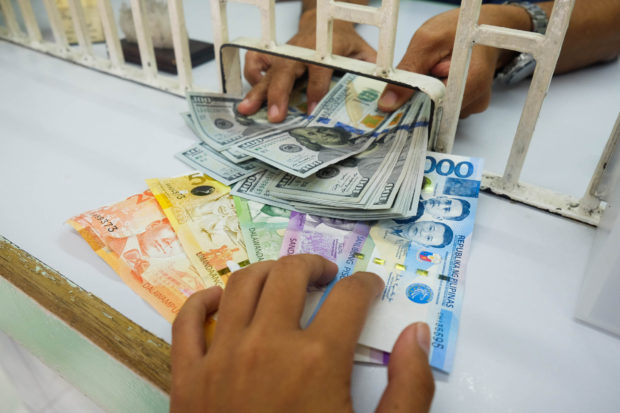Peso grazes all-time low of 56.45:$1
The Philippine peso dropped to its weakest of 56.45:$1 in intraday trading on July 12 before recovering slightly to close at 56.37 against the US dollar, firming up predictions that the local currency is poised to lose more value against the greenback.
ING Bank blamed the peso’s continued weakness on the Bangko Sentral ng Pilipinas’ (BSP) policy stance, which is dovish compared to that of influential central banks like the United States Federal Reserve, meaning it was less inclined to aggressively raise rates.
Amid high inflation, the BSP has taken a gradual approach to raising interest rates while the US Fed has been revving up and has been hinting at not letting go of the throttle.
ING Bank’s senior Philippines economist Nicholas Mapa said in a commentary that while the BSP took its time, the peso plunged to its weakest levels in nearly 17 years starting in June.
Trade deficit
Mapa said these were happening also at the same time when the country’s trade deficit continued to widen to new records, and inflation broke through the upper end of the BSP’s target range of 2 percent to 4 percent to hit multi-year highs.
“The peso is set to weaken further in the near term as BSP stays dovish while inflation heats up further,” Mapa said.
Michael Ricafort, chief economist at the Rizal Commercial Banking Corp., said Tuesday’s spot trading closed at the peso’s weakest in 17 years and eight months or since Nov. 5, 2004, when it closed at 56.375:$1.
Ricafort said that aside from external factors that weaken the peso, local market sentiment also partly weighed down the local currency due to the increase in new local COVID-19 cases to new levels in four and a half months.
Market sentiment
“But market sentiment was partly offset by relatively lower global crude oil prices that are still among two-month lows as well as the recent downward correction in other global commodity prices and the latest easing in the benchmark 10-year US Treasury yield,” he said.
Further, RCBC’s chief economist said it was still hard to say whether the BSP would intervene in the foreign exchange market to arrest the depreciation of the peso as they did in 2004-2005 when the weakest never went past 56.40s for about two years.
“It’s still a wait-and-see what the local authorities would do,” Ricafort said. “Would they raise the local policy rate more to support the peso?” INQ

